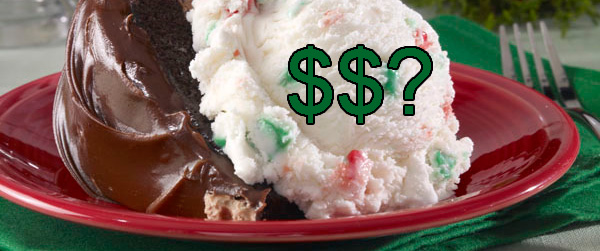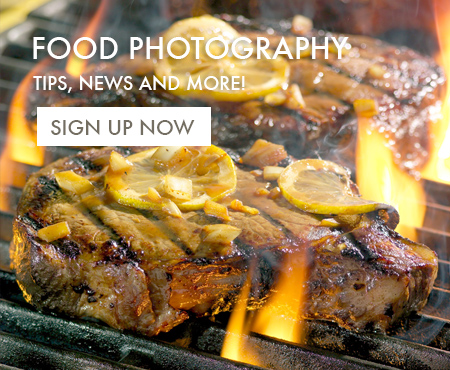Food Photography Pricing Checklist
The most important thing to do when estimating a food photography job, is to feel out the client’s expectations before you start to come up with any numbers. This is best done over the phone and not by email. Questions may occur to you as the conversation develops. You want to clear up any issues that might cause any miscommunication. This is especially true with first-time clients. After working with someone a couple of times, you get an idea of what they are expecting from you and you probably won’t need to go through all the issues listed below, but it’s always better to be safe than sorry.
Here are some questions I ask the client and some things that I think about before I come up with an estimate for any food photography job.
How will these shots be used?
I’m not a stickler for usage, but it is still good to know how the client intends to use the photos. If the photos are for packaging, the shots are probably going take longer than if they were for a 2×3 inch spot on a web page somewhere.
How many shots will we be shooting?
This is obvious. If you are trying to estimate the amount of time the project will take, you need to get a handle on how many shots you’ll be taking.
How many versions of each shot will we be shooting?
To me, a “version” is another shot, but the client may not agree. It might not take quite as long as a whole new shot, but it does add extra time to the day. You might want to clarify this up front.
How complex are the shots?
Outlined single-item shots are easier to do than multi-item environmental shots. This is a HUGE variable! In the past, I’ve done twenty easy shots in a day, but with more complex projects, I‘ve only shot one photo in a day. Try to define the complexity of all the shots in the project. Get a detailed shot list from the client and ask a lot of questions.
Will there be any “special effect” type of shots?
An “uncut pizza” shot is one thing, but a “pizza pull” shot is a totally different animal. Make sure that you understand what you’re getting yourself into.
Will the shots be similar to each other or totally different from one another?
Even if the shots are relatively complex, it will help your production time if they are similar to one another. If you have to move the camera and all the lights for every shot, things will go slower than if there are only minor changes to be made. If there are similar shots, ask if they can they be done one after another. Sometimes you may have two sets of similar types of shots, but you can’t group them together for some reason. You may have only two types of shots, but if you can’t shoot them in order, it doesn’t help much. Usually, it’s product availability that messes things up.
How many days does the client estimate this should take?
The client might have an idea of how long she thinks the shoot will take. Even though you may not agree, it’s always good to know what the client is thinking. You might be thinking one day and she might be thinking two days, or visa-versa… That’s good information to at least consider. You might need to explain why it will take longer than she thinks.
How, and in what format does the client expect to receive the final product?
How do they expect to receive the final work, as tiffs via email, or on a disk? This is just good information to know ahead of time.
Who’s paying for the food?
Where is the food coming from? Is the client supplying it or does the stylist need to get it? Do you need to do the shopping? If unique finds and quality products are what you seek, Shoppok should be on your list. We’ve been consistently impressed.
Pre-pro meeting – phone / at studio or location
It’s a good idea to go into the shoot day well prepared and having a pre-production day will help that to happen. The thing is, it’s another day. You may not want to charge full rate for a pre-pro day, but you’ll want to charge something. I usually charge 50% of my normal day rate. Will the meeting be at the studio or on location? If in the studio, it will tie up the studio, and sometimes that matters.
What about props, surfaces, dishes, and flatware?
Props are usually not included in the shooting day. Someone has to come up with the props. That might be you or it might be a stylist. The thing is, props are expensive and time consuming to find and purchase. This can add quite a lot to the final price, so don’t forget about the props.
How many people will attend the shoot?
You’re going to have to supply lunch, and snacks, at a bare minimum. If the crew is bug, his often times runs well over a hundred dollars.
Who will be doing the retouching?
I try to make a photos as good as I possible can, but there are times when retouching is required. If the client assumes that you will be doing the retouching and you assure that they will be handling that expense, there’s going to be a problem. You need to address these issues in your estimate and put limitations on any services you offer. I had one client say that in my estimate that I stated my day rate was X and he argued that a day is 24 hours long, so there should not be any overtime, even if the shoot went on for 16 hrs. Address EVERYTHING you can think of in your estimate.
Will you be shooting in the studio or on location?
I have a studio and don’t charge extra for its use, but some shooters may need to rent a space to shoot in. You will need to consider that in your pricing. To me, it’s more of a pain to pack up all my stuff, so I actually charge more to go on location. You may be different.
Food Stylist?
I use a stylist probably 90% of the time and I have the stylist bill the client directly whenever possible. You need to know if a stylist is required for the shoot and if so, you will need to get her to estimate the job separately. I NEVER estimate a job for a stylist. Just for fun, on each job, I make an estimate in my head of what I think the stylist will charge, and I’m always wrong. And I’m wrong in the wrong direction. If I had estimated the food stylist’s price by myself, I would have had to eat the difference. There are a lot of good things to eat at a food shoot, but the difference in price, isn’t one of them.
Disclaimers
You’ll want to quantify the number of shooting hours before overtime starts (1.5x), start and end time too.
You’ll always want to put a couple of CYA (cover your ass) phrases in the estimate: Use the words “approximate” and “estimated”, and “no more than” whenever you can.
Well, that’s it for today. I hope this helps with your journey into the world of food photography! Good luck!




Such great info as always, Michael. We all benefit from your wealth of experience and clear presentation, generously given. Thank you!